Academic elements: The Lewis Arts complex includes a new home for the Lewis Center for the Arts’ programs in dance, music theater and theater, and the Princeton Atelier. A new building for music expands facilities for the Department of Music. The complex also includes a gallery for the Program in Visual Arts. These new facilities supplement other arts spaces on campus and help the University realize its vision of a vibrant campus suffused with the arts.
Name: Is referred to informally as the Lewis Arts complex. The Lewis Center for the Arts is named in honor of Peter B. Lewis (1933-2013), a member of Princeton’s Class of 1955 and a former University trustee.
Architect selection: Steven Holl Architects and BNIM Architects, January 2008
Construction commencement: February 2014
Construction completion: September 2017
Project size: 145,000 square feet
Location: The Lewis Arts complex, on the south edge of campus, anchors a 22-acre development that includes two restaurants, a WaWa convenience store and the new Princeton train station. The complex is surrounded by a park-like setting with extensive landscaped plazas, pathways and green spaces. It is adjacent to the McCarter Theatre Center.
Buildings:
- Wallace Dance Building and Theater. Developed according to the idea of a “thing within a thing.” The interior of the Wallace Theater (black box) is finished in perforated black steel, while the Hearst Dance Theater is finished in foamed aluminum; the Roberts Dance Studio, in whitewashed wood; and the Murphy Dance Studio, in board form concrete. A “dancing stair” connects all levels.
- New Music Building. Developed according to an idea of “suspension.” Above the large orchestral rehearsal room, individual practice rooms are suspended on steel rods. Acoustically separate, these wooden chambers have a resonant quality.
- Arts Tower. The six-story stone tower references the proportions of the University’s nearby historic Blair Arch.
The buildings are connected underground by the 8,000 square-foot open Forum below the outdoor plaza. The Forum serves as an indoor gathering space and lobby for the various arts venues in the complex. The outdoor plaza, which features a reflecting pool with skylights that filter natural light into the Forum below, is a gateway space to connect the local community to the University and to invite curiosity and interaction.
Building materials: The steel and cast-in-place concrete structure of the three buildings is faced in thick 21-million-year-old limestone from a quarry in Lecce, in southern Italy, that has been continuously mined for 2,000 years. If you look at the stone closely, you can see small fossils.
Curtain wall glazing: Insulated glass units with Okalux Kapipane infill — a type of insulated glass unit that appears translucent on the building and helps achieve an energy-efficient, high-performance envelope while still letting natural light into the building — supported on steel mullion system, with acid etch finish depending on location; insulated glass supported on steel cable system (New Music Building only); operable windows
Interior materials: American cherry, foamed aluminum, perforated steel, acid etched glass, bamboo, whitewashed ash wood, painted wood, walnut, bead blast stainless steel
Main performance/exhibit spaces: Wallace Theater (black box), Hearst Dance Theater, Lee Music Performance and Rehearsal Room, Roberts Dance Studio, Donald G. Drapkin Studio, Hurley Gallery, Roth Box Office
Studios:
- Music. PLOrk Studio, Lee Jazz Studio, percussion studio, piano studios, Rafner Teaching Studio, Spies Family Teaching Studio, Lucas Teaching Studio, Lee Digital Recording Studio, 17 practice rooms
- Theater. Tilghman Theater Studio, Godfrey Kerr Theater Studio, theater studio
- Dance. Murphy Dance Studio, dance studio
- Shared. CoLab, Vasen Design Studio, costume shop, scene and prop shop, seminar room
Project team: Steven Holl Architects, BNIM Architects (associate architects, architect of record), Michael Van Valkenburgh Associates (landscape architects), Ove Arup & Partners (structural, mechanical/electrical/ plumbing, lighting, acoustic and technology engineers), Front Inc. (façade consultant), Auerbach-Pollock-Friedlander (theatrical systems consultant), Vanasse Hangen Brustin, Inc. (civil engineer), R.W. Sullivan Engineering (codes), IBA Consulting and Engineering (waterproofing consultant)
Construction manager: Turner Construction Company
Sustainability elements: Geothermal heating and cooling; green roofs to decrease rate and run-off of storm water and improve water quality; material and landscape designed to reduce heat island effect for roof and non-roof; high-performance exterior envelope (glazing and thermal mass); closed loop ground source heat pumps (139 wells, 500′ deep); natural ventilation and light; interior shading; sensor-based equipment; storm water management, water reduction through high-efficiency fixtures; LED building and theatrical lighting; LEED enhanced commissioning; construction waste reduction.
Trees: Some 490 new trees planted on the arts and transit project, 21 of which are on the Lewis Arts complex site, including several 12” caliper American Beech trees and a variety of oak species. Seventeen existing trees were protected to remain, including a Civil War-era Ohio Buckeye.
Other landscaping highlights: The Arts Plaza, formed between the three main buildings, is a 5,250-square-foot planted pavement green roof over the Forum space. At its center is a 4,500-square-foot reflecting pool with 12 skylights that bring natural light down to the space below. Stone benches are integrated in the stone facades and reflecting pool edge for seating, and bluestone pavers are placed in different densities including open planted joints. The landscape was developed with MVVA architects. A new work by the internationally acclaimed artist Maya Lin has been commissioned for the grounds. Additional details about the commission will be announced later in the fall.


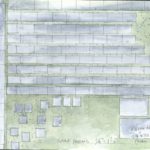
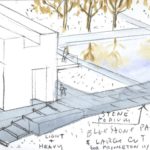
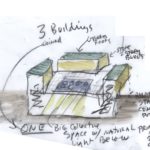
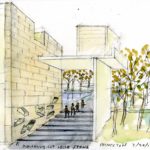

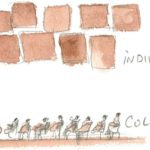
 © 2017 the Trustees of Princeton University
© 2017 the Trustees of Princeton University